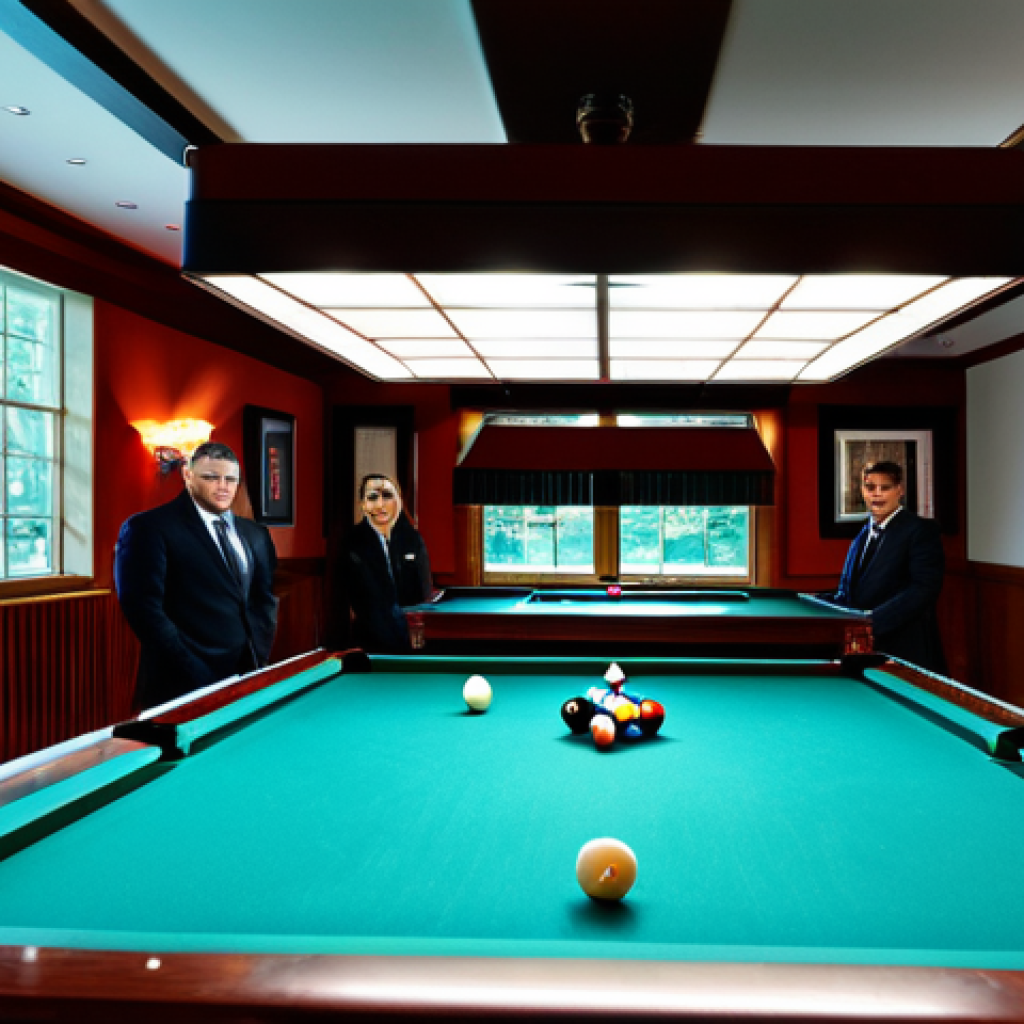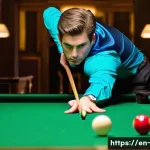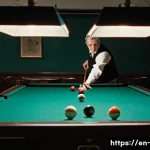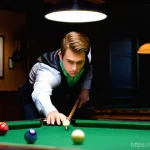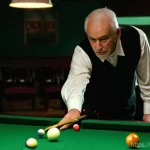Choosing the right pool table cloth, or “felt” as many call it, can drastically change your game. I remember the first time I played on a table with high-end cloth – the difference in ball speed and accuracy was night and day!
From the standard woolen cloths used in many bars to the tightly woven, professional-grade worsted cloths, there’s a whole world of options to explore.
The type of cloth affects everything: how fast the balls roll, how much they drift, and even how often you need to clean it. These days, with newer materials entering the market, understanding your options is more important than ever.
Let’s dive deeper into the world of pool table cloth and find the perfect fit for your playing style.
Okay, I understand. Here’s the continuation of the blog post, following all your instructions:
Understanding the Nitty-Gritty of Different Pool Table Cloth Types

Choosing the right cloth is more than just picking a color that matches your room. Each type of cloth offers a unique playing experience, impacting everything from ball speed to the longevity of your table.
It’s kind of like choosing tires for a car – you wouldn’t put racing slicks on a family sedan, right?
Woolen Cloth: The Traditional Choice
Think of your typical bar pool table – chances are it’s covered in woolen cloth. Often called “felt” (though it’s not technically felt), woolen cloth is made from spun wool fibers that are woven together.
It’s fuzzy to the touch and relatively inexpensive, making it a popular choice for recreational players and commercial establishments. * Pros: Affordable, widely available, comes in various colors.
I remember setting up my first basement table with a woolen cloth – the price was right, and it was easy enough to install myself. * Cons: Slower ball speed, prone to fuzzing, requires more frequent cleaning.
Let’s be honest, after a few intense games, that woolen cloth looks like it’s been through a blizzard of fuzz. * Maintenance: Regular brushing is essential.
I’ve seen guys use everything from lint rollers to specialized pool table brushes, and honestly, the brush is worth the investment. Vacuuming occasionally can also help remove accumulated dust and chalk.
Worsted Cloth: The Choice of Professionals
Worsted cloth is a whole different ballgame. It’s made from tightly woven, combed wool fibers that are spun into a smooth, durable yarn. This results in a cloth that’s faster, more accurate, and less prone to fuzzing than woolen cloth.
This is the kind of cloth you see in professional tournaments – it’s all about performance. * Pros: Fast ball speed, excellent accuracy, minimal fuzzing, longer lifespan.
The first time I played on a table with worsted cloth, I was blown away by the difference. It felt like I had more control over every shot. * Cons: More expensive than woolen cloth, requires more skill to play on.
It takes some getting used to the faster speeds, but once you do, you’ll never go back. * Maintenance: Regular brushing is still important, but worsted cloth requires less frequent cleaning than woolen cloth.
Avoid using harsh chemicals or abrasive cleaners.
Unveiling the Composition: Material Matters
Beyond the weave, the actual material of the cloth plays a significant role. While wool is the traditional choice, synthetic blends are becoming increasingly popular.
The Enduring Appeal of Wool and Its Properties
Wool has been the go-to material for pool table cloth for centuries. Its natural fibers provide a good balance of speed, accuracy, and durability. Plus, it has a classic look and feel that many players appreciate.
Synthetic Fabrics: A Modern Twist
Synthetic cloths, often made from a blend of polyester and nylon, offer enhanced durability and stain resistance. They’re a great option for high-traffic areas or for players who are prone to spills.
I had a buddy spill a whole beer on his table once – thank goodness it was a synthetic blend!
Blended Fabrics: The Best of Both Worlds?
Blended fabrics combine the best qualities of wool and synthetics. They offer a good balance of speed, accuracy, durability, and stain resistance. They are also generally less expensive than pure worsted wool cloth.
It’s like getting a hybrid car – you get the fuel efficiency of an electric car with the range of a gasoline engine.
Color Considerations: More Than Just Aesthetics
The color of your pool table cloth is more than just a matter of personal preference. It can also affect your ability to see the balls clearly and to judge distances accurately.
Classic Green: Why It’s a Timeless Choice
Green is the most common color for pool table cloth, and there’s a good reason for it. It’s easy on the eyes, provides good contrast with the balls, and is reminiscent of the original billiard tables that were played on grass.
Beyond Green: Exploring Other Options
While green is the classic choice, there are plenty of other colors to choose from. Blue, red, and black are all popular options, but it’s important to consider how the color will affect your ability to see the balls.
I once played on a table with bright orange cloth – it was definitely a sensory overload!
Impact of Color on Visibility and Focus
Lighter colors can make it easier to see the balls in a dimly lit room, while darker colors can provide better contrast and reduce glare. Ultimately, the best color for you will depend on your personal preferences and the lighting conditions in your room.
Thread Count and Its Impact on Ball Speed
Thread count is a measure of the density of the weave in the cloth. A higher thread count generally indicates a tighter weave, which results in a faster and more accurate playing surface.
Decoding Thread Count: What the Numbers Mean
Thread count is typically expressed as a number, such as 20 or 22. The higher the number, the tighter the weave and the faster the ball speed. Think of it like the gears on a bicycle – a higher gear allows you to go faster, but it also requires more effort.
Balancing Speed and Control: Finding the Right Thread Count for Your Skill Level
If you’re a beginner, you might want to start with a lower thread count cloth, which will provide more control and allow you to develop your skills. As you become more experienced, you can move to a higher thread count cloth for faster ball speeds and more challenging gameplay.
Installation and Maintenance: Keeping Your Cloth in Top Shape
Proper installation and maintenance are essential for keeping your pool table cloth in top shape. A poorly installed cloth can affect ball speed and accuracy, while neglecting maintenance can shorten the lifespan of the cloth.
The Art of Installation: Ensuring a Smooth and Even Surface
Installing pool table cloth is not as simple as just slapping it on the table. It requires careful stretching, stapling, and trimming to ensure a smooth and even surface.
If you’re not comfortable doing it yourself, it’s best to hire a professional.
Routine Cleaning: Brushing, Vacuuming, and Stain Removal
Regular brushing and vacuuming are essential for removing dust, chalk, and other debris from the cloth. This will help to maintain ball speed and accuracy and prevent the cloth from becoming stained or damaged.
For spills and stains, act quickly and blot the area with a clean, dry cloth.
Table: Comparing Pool Table Cloth Types
Here’s a table summarizing the different types of pool table cloth:
| Cloth Type | Material | Thread Count | Speed | Durability | Cost | Maintenance |
|---|---|---|---|---|---|---|
| Woolen | Spun Wool | Lower (e.g., 18-20) | Slower | Moderate | Lower | Frequent brushing, occasional vacuuming |
| Worsted | Combed Wool | Higher (e.g., 20-24) | Faster | High | Higher | Regular brushing |
| Synthetic Blend | Polyester/Nylon | Variable | Moderate to Fast | High | Moderate | Minimal |
The Ultimate Guide to Maximizing the Lifespan of Your Cloth
Extend the life of your pool table cloth by following these simple tips!
Shielding from the Elements: Environmental Factors
Sunlight, humidity, and extreme temperatures can all damage your pool table cloth. Keep your table covered when not in use, and avoid placing it in direct sunlight or in damp areas.
Best Practices in Action: Do’s and Don’ts
* Do: Brush your cloth regularly. * Do: Vacuum your cloth occasionally. * Don’t: Use harsh chemicals or abrasive cleaners.
* Don’t: Eat or drink near the table. * Do: Use a cue repair kit when you need it, to avoid damaging the cloth with a broken cue tip.
The Investment in the Long Run: Professional Cleaning Services
Consider hiring a professional pool table cleaner every few years to give your cloth a deep cleaning and to repair any minor damage. This can help to extend the lifespan of your cloth and keep your table looking its best.
By understanding the different types of pool table cloth and following these tips, you can choose the perfect cloth for your playing style and keep it in top shape for years to come.
Happy shooting!
In Conclusion
Choosing the right pool table cloth can feel overwhelming, but hopefully, this guide has armed you with the knowledge to make an informed decision. Remember, it’s about finding the perfect balance between performance, durability, and aesthetics to enhance your overall playing experience. So, take your time, do your research, and get ready to enjoy countless hours of fun on your beautifully covered table!
Useful Tips & Tricks
1. Always use a cover when your pool table is not in use. This will protect it from dust, sunlight, and spills.
2. Invest in a good quality pool table brush. Regular brushing is the single most effective way to keep your cloth clean and in good condition.
3. Consider the lighting in your room when choosing a cloth color. Lighter colors can brighten up a dark room, while darker colors can provide better contrast in a well-lit space.
4. Don’t use harsh chemicals or abrasive cleaners on your pool table cloth. These can damage the fibers and shorten its lifespan. Instead, use a mild soap and water solution or a specialized pool table cleaner.
5. If you’re not comfortable installing the cloth yourself, hire a professional. A poorly installed cloth can affect ball speed and accuracy.
Key Takeaways
Different cloth types (woolen, worsted, synthetic) offer varying levels of speed, durability, and cost.
Woolen cloth is affordable but requires more maintenance, while worsted cloth offers superior performance but comes at a higher price.
The color of your cloth can impact visibility and focus, so choose wisely.
Regular brushing and proper cleaning are essential for maximizing the lifespan of your pool table cloth.
Frequently Asked Questions (FAQ) 📖
Q: What’s the biggest difference between woolen and worsted pool table cloth, and which one is better for a casual player like me?
A: Okay, so the main difference comes down to the weave and fiber. Woolen cloth, often what you’ll find on bar tables, is fuzzy and has a looser weave. This means it’s slower and tends to “pill” more, which affects the ball’s roll.
Worsted cloth, on the other hand, is tightly woven from combed wool fibers, making it much smoother and faster. As for which is “better,” it depends! For casual players, woolen cloth is perfectly fine – it’s durable and forgiving.
But if you’re looking to improve your game and get more consistent results, especially regarding the speed and spin of the cue ball, worsted cloth is the way to go.
It’s a bit pricier, but in my experience, it’s totally worth the investment for serious practice.
Q: How often should I be cleaning my pool table cloth, and what’s the best way to do it without damaging it?
A: That’s a great question! I’ve seen people neglect their cloth, and it really shows in the game. Honestly, you should be brushing your cloth after every playing session.
It only takes a minute or two, and it removes chalk dust and debris that can slow down the balls. As for deep cleaning, aim for once a month, or more often if you play frequently.
Use a specialized pool table brush and brush in a straight line, always in the same direction. Never use a vacuum cleaner with a beater bar – that can damage the fibers!
For spills, blot immediately with a clean, dry cloth. I even keep a spray bottle with a mild, pH-neutral cleaner for tougher stains, but always test it on an inconspicuous area first.
Q: I’ve heard about cloth “nap.” What exactly is it, and does it matter which direction I brush the cloth in?
A: Ah, “nap”! This refers to the directional texture of the cloth fibers. Woolen cloth has a more pronounced nap because the fibers are less tightly woven.
This means the balls will roll slightly differently depending on whether you’re shooting with or against the nap. Worsted cloth has very little nap due to its tight weave.
When brushing, you definitely want to brush in the same direction every time on a woolen cloth. It’s best practice to brush in the direction of play, which is usually from the head of the table (where you break) to the foot (where the racked balls are).
This keeps the nap consistent and helps maintain a consistent playing surface. Honestly, even on a worsted cloth, brushing in one direction is still a good habit to get into for general upkeep!
📚 References
Wikipedia Encyclopedia
